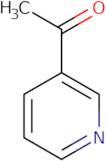3-Acetylpyridine
CAS: 350-03-8
Ref. 3D-FA17162
| 25g | Descatalogado | ||
| 50g | Descatalogado | ||
| 100g | Descatalogado | ||
| 250g | Descatalogado | ||
| 500g | Descatalogado |
Información del producto
- 1-(3-Pyridinyl)ethanone3-Pyridinyl methyl ketoneMethyl 3-pyridyl ketone
- 1-(3-Pyridinyl)ethanone
- 1-(3-Pyridyl)ethanone
- 1-(Pyridin-3-yl)ethan-1-one
- 1-(Pyridn-3-yl)ethanone
- 1-Pyridin-3-Ylethanone
- 3-Acetal Pyridine
- 3-Acetopyridine
- 3-ActylPyridine
- 3-Pyridinyl methyl ketone
- Ver más sinónimos
- 3-Pyridyl methyl ketone
- 3-Pyridylethanone
- Acetyl-3-Pyridine
- Ethanone,1-(3-pyridinyl)
- Ketone, methyl 3-pyridyl
- Methyl (3-pyridyl) methanone
- Methyl 3-pyridyl ketone
- Methyl pyridin-3-yl ketone
- Methyl β-pyridyl ketone
- Methyl-3-pyridylcetone
- Methyl-3-pyridylketon
- Metil-3-Piridilcetona
- Nsc 761
- Pyridine, 3-Acetyl-
- β-Acetylpyridine
3-Acetylpyridine (3AP) is a molecule that has been shown to be neuroprotective in vitro and in vivo. It prevents neuronal death by inhibiting the activity of enzymes that are responsible for the production of reactive oxygen species. 3-Acetylpyridine also inhibits granule neuron loss and cell death due to apoptosis, as well as the activation of caspases, which are proteins involved in apoptosis. 3-Acetylpyridine may also have therapeutic benefits for patients with Parkinson’s disease, as it has been shown to inhibit the enzyme tyrosine hydroxylase, which is responsible for dopamine synthesis.
3-Acetylpyridine was found to increase locomotor activity in mice when administered intraperitoneally at doses of 50mg/kg or 100mg/kg. This could be due to its ability to stimulate dopaminergic systems in the brain.





